Police report a homeless man set fire to the enormous monument near Saeng Chan beach in Rayong, Thailand, on Saturday. The massive monument depicts Nang Phisuea Samudra, a sea ogress and the primary character in Sunthorn Phu’s famed epic poem Phra Aphai Mani.
According to authorities, the homeless man set fire to Rayong’s iconic giant statue on Saturday afternoon, and local people now worry for their safety as a result of the damage to the edifice.
When police arrived on the scene of the fire on Saeng Chan beach, they saw locals working quickly to extinguish flames that rose as high as three meters, according to witnesses. It apparently took just over 10 minutes to put out the fire.
Authorities examined the statue’s damage and discovered that its torso had been burned and the figure’s upper garment had been damaged. Smaller statues of other mythical beings, which had been put in tribute around the main sculpture, had also been damaged.
Ratana Deebang, 52, a local seller, said she noticed a vagrant circle the monument before the fire broke out and called on others nearby to help put it out.
After questioning witnesses, police seized a 35-year-old man known only as Ming, who appeared to be mentally unstable. He was taken from the area, and medical attention was sought.
Locals are concerned that the occurrence may bring bad luck to the neighborhood because the statue is considered sacred. Some people were spotted pooling their resources to replace the charred clothing.
The monument depicts Nang Phisuea Samudra, a sea ogress and the major character in the epic poem Phra Aphai Mani by Rattanakosin Dynasty bard Sunthorn Phu (1786-1855).
The statue was built to serve as a tourist attraction, but it became famous after several people claimed to have found love after praying to it. Locals say the spot is especially packed on the day before national lottery draws.
Superstitions in Thailand
Thailand, like many other cultures, has a rich tapestry of superstitions that are deeply rooted in its history, religion, and folklore. Superstitions in Thailand often blend elements of Buddhism, Hinduism, and traditional beliefs. Here are some common superstitions in Thailand:
- Spirit Houses (San Phra Phum): Many Thai people believe in spirits that inhabit the land. Spirit houses, small ornate structures, are often placed outside homes and businesses to provide shelter for these spirits and bring good fortune to the occupants.
- Ghost Beliefs: There are various ghost stories and beliefs in Thailand. For example, the “Phi” is a general term for ghosts or spirits, and there are different types with specific characteristics. The belief in ghosts is deeply rooted in Thai culture, and there are many traditional ghost stories passed down through generations.
- Lucky and Unlucky Numbers: Similar to many Asian cultures, certain numbers are considered lucky or unlucky in Thailand. The number 9, for example, is often considered lucky because it sounds like the word for “progress.” Conversely, the number 4 is associated with bad luck because it sounds like the word for “death.”
- Astrology: Thai people may consult astrologers for guidance on auspicious dates for important events, such as weddings or business openings. Astrology is also used to determine an individual’s characteristics and compatibility with others.
- Takrut: These are small metal or cloth amulets inscribed with sacred verses or symbols. Many Thais believe that wearing a takrut can provide protection and bring good luck.
- Taboos and Cultural Practices: There are numerous taboos and cultural practices in Thailand. For example, pointing your feet at sacred objects or people is considered disrespectful, as the feet are considered the lowest part of the body. Additionally, touching someone’s head is considered impolite, as the head is considered the most sacred part of the body.
- Sai Sin (Sacred Threads): Sai Sin is a type of sacred thread blessed by Buddhist monks. People wear these threads as bracelets or necklaces for protection and good fortune.
- Animist Beliefs: In addition to Buddhist and Hindu influences, animist beliefs are still prevalent in some Thai communities. These beliefs involve spirits residing in natural elements such as trees, rivers, and mountains.
It’s important to note that while these superstitions are widely observed by many Thai people, not everyone adheres to them, and the level of belief can vary among individuals. Thailand’s cultural and religious diversity also contributes to a wide array of beliefs and practices.





























